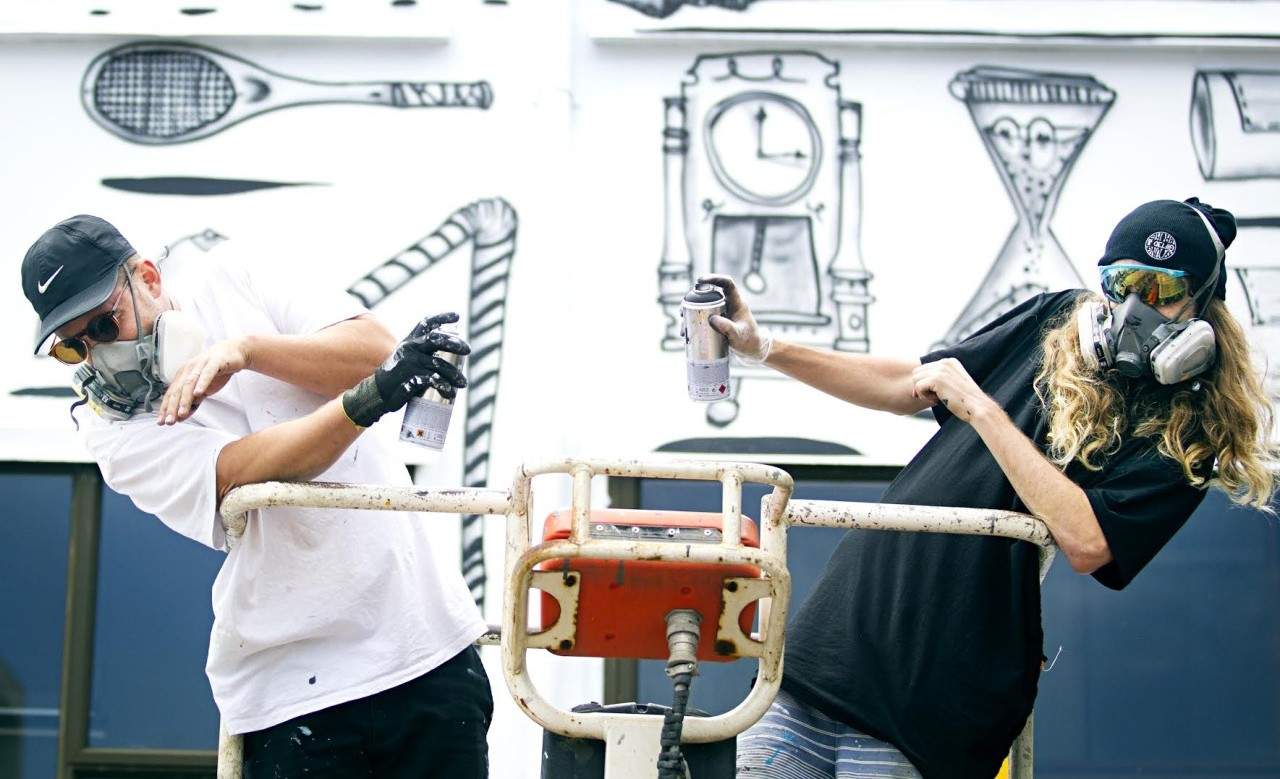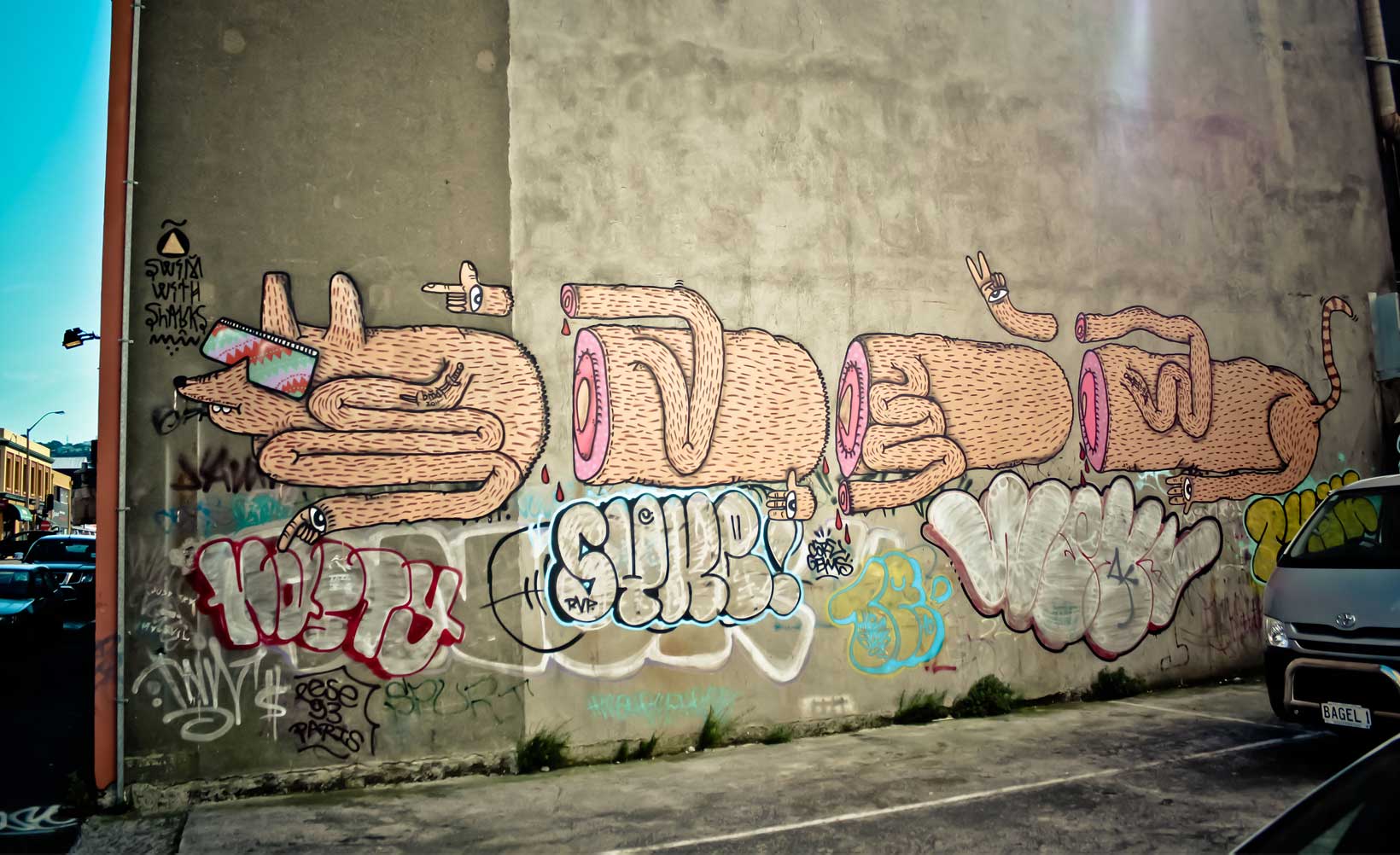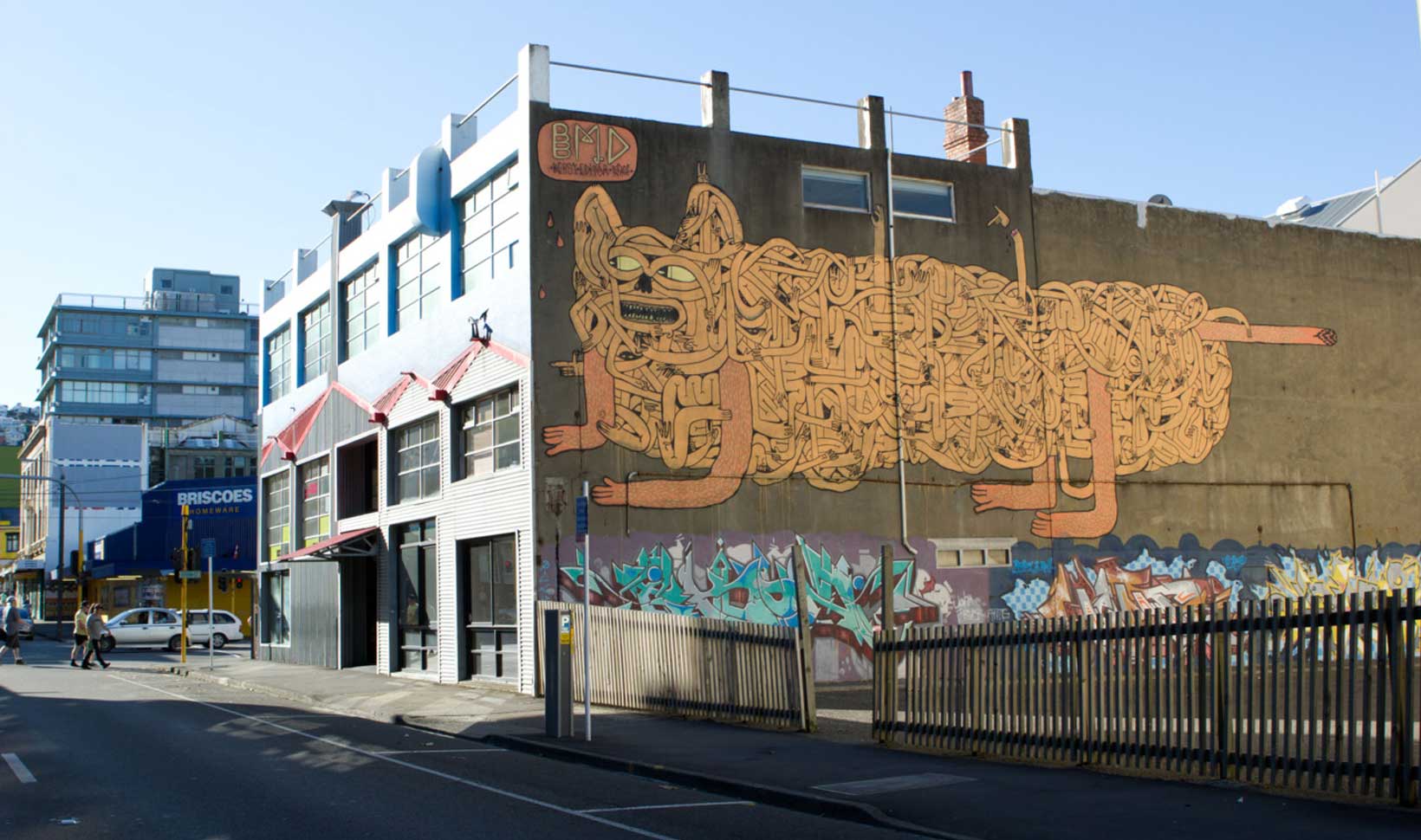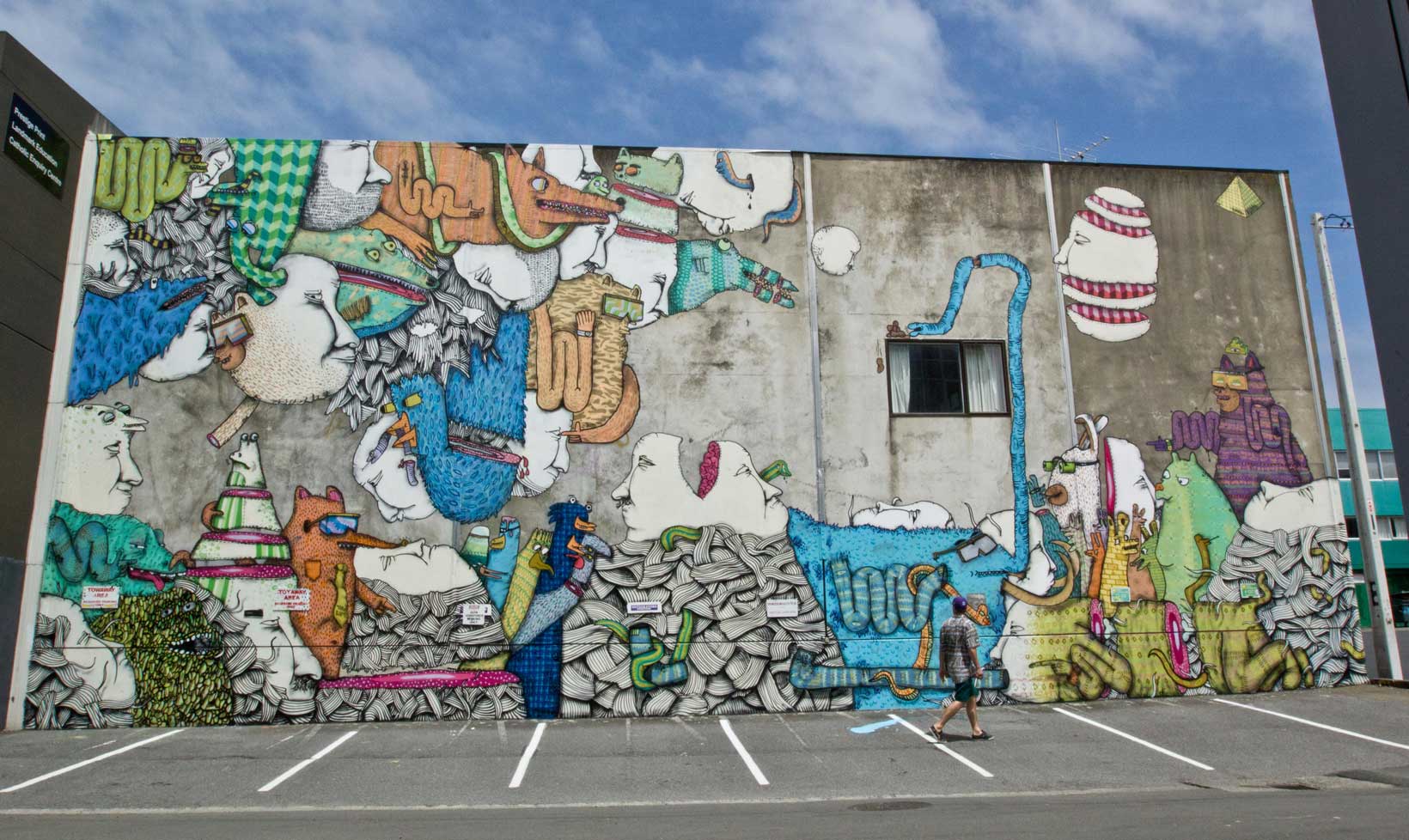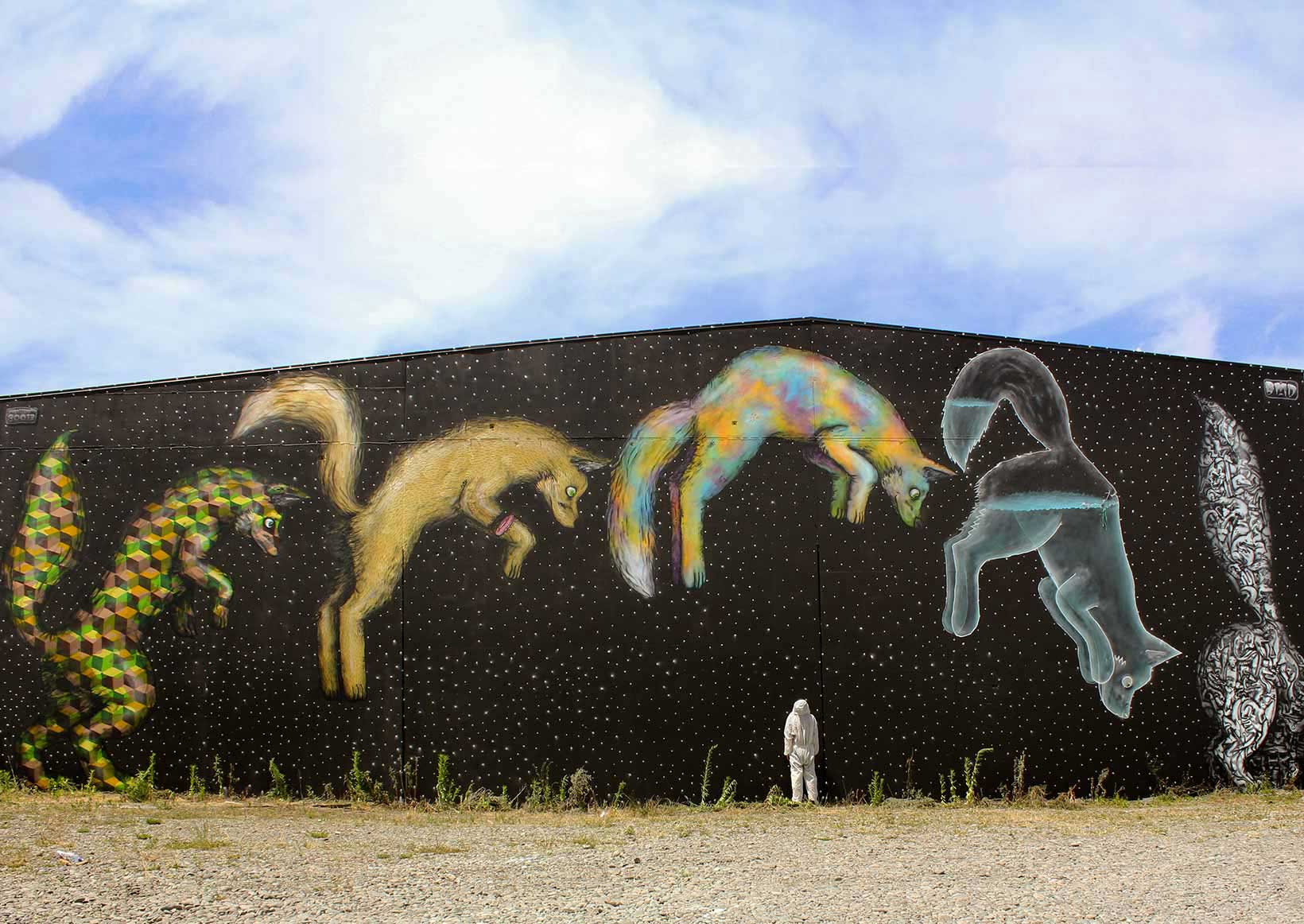BMD Thinks Safety is a Place Where Creativity Goes to Die
"There are big challenges with working large scale outdoors, opposed to the fine artist who can sit inside, work in peace on his work with a cup of tea and the heater on. But how boring is that?"
As kids we are taught that ‘graffiti’ is a dirty word. Images are conjured of slimy alleyways with (probably) meth-eyed hooded figures clasping spray cans. Ingrained in us is the idea of a taboo practice, that only those who have done time can rattle out the prints we see. But it’s artists like the guys from BMD that help to transform the idea of graffiti into an accessible form of street art. Wellington is just one example of how prolific the duo is, housing many of their clever and quirky street work.
Although they refused to take off their masks and provide any more than an initial to go by, we got a chance to catch a glimpse of what goes on in the two mysterious artist’s minds.
Concrete Playground: Why do you think New Zealand is such a good place for creative minds?
A: I think it’s a country that almost forces entrepreneurship out of people. We have an incredible DIY culture that resonates everywhere. It breeds really innovative people who think and approach things differently, which is a good culture to be a part of.
D: The isolation of New Zealand has multiple effects, both as an incubator; letting artist grow and get significant feedback and public response. On the other side of that our isolation causes a detachment from the rest of the foreign creative world.
Untitled, Oakland (USA), 2015.
CP: Is there a deeper psychological element to BMD’s humanising of animals where they are often dismembered to generate a narrative in a zoetrope way?
A: Cartoons have a beautiful simplicity about them. They’re universal and they have an ability to communicate an idea or be purely decorative, depending how you use them.
D: There is some animalised works we paint for the animals to see, though most of our works are aimed at humans. Often we'll try inject a static environment with energy and motion, so zoetrope styled compositions are a direct and effective way to do this. Several years ago through reflection we came to a refined realisation that what we had been doing was a study of our characters; learning what they were, their insides and their movements, their attitudes. Basically, we were doing a research assignment on ourselves.
Untitled, Wellington, 2011. Photo: Blaze Dunlop
CP: Would you say that BMD’s fascination with dissection has changed over the years? In a 2012 interview with Massive Magazine you said that your anatomy experimentation started during a dark time, that “we were like ‘fuck all this happy lovey-dovey street art…’” and there was “always a girl involved somewhere with this kind of shit”.
A: We’ve come a long way with our work – its always a journey with any creative process. Life has its ups and its downs, and people resonate those in different ways, our way has been through our work. I think we’ve matured a lot in the past few years. We’ve changed focusing bad energy on content of artwork, to output of artwork. If you can turn a bad situation into fuel you’re doing something right.
D: Everything affects everything and we try to keep our work real to who we are. So the impact from important relationships ending has no doubt been a factor in the founding or drive of visual concepts, in particular the splitting and separation of our characters. As we've grown the influence and effect of our personal lives has never been detached.
Untitled, Taupo, 2011. Photo: Nigel Roberts
CP: Do you think street art/ graffiti is special in what it has to offer compared to galleries?
A: The art world is a funny world. Public arts have the ability to mass communicate and get instant gratification, but are incredibly difficult to make a living from, so it’s a difficult balance. There are big challenges with working large scale outdoors, opposed to the fine artist who can sit inside, work in peace on his work with a cup of tea and the heater on. But how boring is that? Safety is a place where creativity goes to die.
D: The perimeters of what street art/graffiti and also what a gallery has become is so blurred. A gallery being a controlled space with deliberate placements will always emphasise the importance and luxury of any art form. However, I think the importance and further the public's desire for this is shifting.
If the ice melts, the penguins will too, Christchurch, 2014. Photo: Bevan Triebels
CP: BMD’s environmental focused artworks Maui Dolphins ‘The last 55 left’ and 'If the ice melts the penguins will too' resulted in BMD doing a few school talks. What was that experience like for you guys who started out as not quite legal street artists and now are talking to the youth about serious worldly issues?
A: We’ve captured some attention and imagination with our work and used it as a vehicle to create meaningful experiences. To me, that’s what it’s all about. It’s funny how much things have spun 180 degrees – ‘spray-painters’ used to be the kids your parents warned you about, now we’re invited to do talks, create works for fantastic causes and people are paying attention. Our approach and goals have changed as we’ve matured from when we did a lot of illegal work.
D: Whether we were consciously aware initially or not, through BMD we've been trying to refine a language which we can use to make change. In the early days our most effective method was without permission. As we grew, so did our eyes, and resultantly our methods. Getting permission and working with people as a posed to sneaking around created stronger platforms to carry bigger messages.
CP: Is there a reason that you have a primary focus on animals in all of these environmental issues?
A: I’m a geek at heart and from a formal life-science background, so I have a baseline concern about the planet and everything on it. I’ve always been really interested in facts and statistics about the world, but they are often poorly communicated. I think that’s half the battle with environmental issues. There is no shortage of concerns and issues in the world; I’m hoping to further our work around extinction and climate issues. I also want to work towards communicating more human-based issues around mental health and suicide as these are also huge problems that have big communication challenges around them.
D: We really like animals, and they can't really paint walls for themselves. Personally, one of my primary motives for the existence of BMD is that of continuing and growing the ability for it to talk, for it to have an effective enough voice when it one day is most needed.
Untitled, Wellington, 2012. Photo: Blake Dunlop
CP: Who do you think is the next up and coming New Zealand street/graffiti artist?
A: My favourite artists in the public domain are Gary Silipa/TGTB, he’s a genius, creates simple but meaningful work and so many of his ideas resonate with me. Another young kid called Ash Sisson/Chimp is doing good things, he’s got great work, great work ethic and he looks like he’s half my age, little shit.
D: This is something we've talked about, and we feel there seems to be a bit of a deficit over the last few years in abundance of the younger cat's getting out there and staying prolific. The next person to watch is the one who's working the hardest, being the most original and most prolific while letting everyone know they're doing it.
Keep a tab on their work via bmdisyourfriend.com and their Instagram @bmdisyourfriend.
Photo credit: Charlotte Curd
